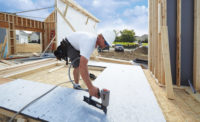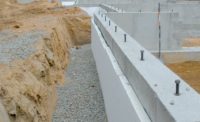Located near America’s coldest city of Fairbanks, Alaska, Fort Greeley is home to the U.S. Army’s Cold Regions Test Center. With average winter low temperatures of -15 degrees to -25, the base’s Sub-arctic environment makes it challenging to keep housing for military professionals warm.
At Fort Greeley, and nearby Fort Wainwright, Lend Lease Public Partnerships has built 275 military housing units, with 45 new units planned at its North Haven Communities project. North Haven is a partnership between Lend Lease and the U.S. Army and is a privatized military residential community that’s home to more than 1,700 service members and Department of Defense personnel. To help meet stringent LEED for Homes Silver Level energy efficiency requirements, the company used R-Tech expanded polystyrene insulation from Insulfoam.
“The EPS has been tested by the cold climate consultant for the project, and documented by REMOTE wall contractors as a preferred insulation product,” says Greg Starkey, senior construction manager for Lend Lease. “Our research and cost comparisons to other insulations concluded that EPS provides the best exterior insulation results for the price. We chose Insulfoam EPS because it had extensive information available to help analyze the product.”
Lend Lease installed EPS insulation on the housing units’ foundation perimeters, both vertically and horizontally (away from the house), to trap heat below the foundation slab. This was done to help keep the soil below the slab in a thawed state, notes Starkey, which helps to minimize the risk of seasonal frost heave. The bottom of the slab was also insulated with EPS to retain heat in the slab. Further, the company used EPS insulation on the homes’ exterior walls, helping to create a warm and comfortable interior environment, and energy-efficient housing, despite the bases’ location near the Arctic Circle.
EPS insulation can be used anywhere in the building envelope, and also provides the highest insulating R-value per dollar among rigid foam insulations.
EPS Insulation Below-grade Performance
When selecting insulation for below-grade applications, it is crucial to evaluate the product’s moisture resistance, as wet insulation has lower thermal performance.
There is much confusion in the marketplace regarding whether EPS or XPS insulation resists moisture better. While manufacturers of both insulation types tout that their products have lower moisture absorption, in-situ tests indicate that EPS performs better in this regard.
In 2008, Stork Twin City Testing, an accredited independent testing laboratory, examined sheets of EPS and XPS removed from a side-by-side installation after 15 years in service on a below-grade foundation in St. Paul, Minn. The XPS was significantly wetter on extraction, with 18.9 percent moisture content by volume compared to 4.8 percent for the EPS. After 30 days of drying, the XPS still had elevated moisture of 15.7 percent, while the EPS had dried to 0.7 percent.
The U.S. Dept. of Energy’s Oak Ridge National Laboratory also reports high moisture absorption levels for XPS. In a 2012 study, the lab reported “all samples of XPS insulation gained much more moisture during the 15 years of contact with soil moisture.” The resulting loss of energy savings performance was 10 percent for a full basement and 44 percent for a slab-on-grade installation.
By comparison, the U.S. Army Cold Regions Research and Engineering Laboratory found EPS buried in wetted soil for 1,000 days absorbed only 1.7 percent moisture by volume, which is substantially lower than the XPS rates noted above.
Despite these findings, many XPS manufacturers say their products absorb less moisture than does EPS. However, this is usually based on standardized short-term tests conducted inside laboratories that do not reflect actual field exposure as do the above in-situ tests.










Report Abusive Comment